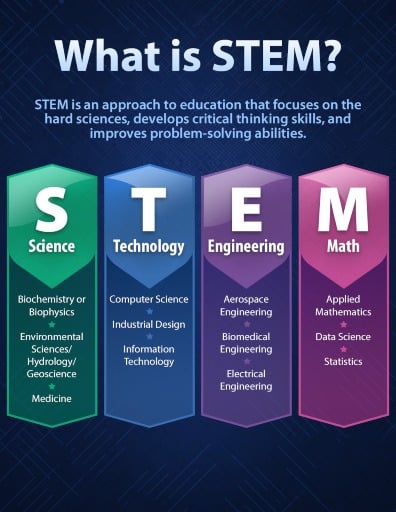STEM education teaches children more than just science and mathematics concepts. It also puts importance on equipping future generations to be successful in their careers.
In fact, according to the U.S. Department of Commerce Economics and Statistics Administration, employment in STEM occupations grew much faster than employment in non-STEM occupations over the last decade (24.4% vs. 4.0%, respectively).

Learn more about Stem Education and why it is important, as discussed by experts.
Table of Contents
- The term “STEM education” refers to learning and teaching in the domains of science, technology, engineering, and math
- STEM education provides opportunities for building the next generation of scientists, engineers, mathematicians, and critical thinkers
- STEM learning encourages experimentation
- STEM education also promotes problem-solving
- STEM encourages teamwork
- In STEM Education, students study topics using hands-on, real-life situations and example
- Stem prepares kids for their careers
- STEM helps kids find jobs
- STEM teaches kids thinking skills
- STEM education is based on four specific disciplines — science, technology, engineering, and mathematics
- STEM is an exploratory mindset, the ability to see connections between what we learn and the world around us
- Stem Education fosters creativity and curiosity
The acronym STEM has seen popularity in education, software, and even in the toy market. This has led us to use “STEM” as a word-acronym, like GIF, AIDS, or SCUBA. STEM has been most often used in reference to educational program priorities.
A STEM-education focuses on Science, Technology, Engineering, and Math. The belief is that these will help prepare our learners to compete in their future economy. Many policymakers, economists, and futurists believe a solid foundation in STEM will make us more successful.
In our increasingly globalized economy, the spread of products, technology, information, and jobs is occurring across national borders and cultures. This “globalization” has increased discussions about the relevance of STEM in education and how a STEM education leads learners to better understand the interconnectedness of concepts and ideas.
History of STEM
For decades, in the United States, national policy documents have argued that our global competitiveness relies on students’ engagement in science, technology, engineering, and mathematics (STEM).
In response to growing concerns about our future workforce, the term “STEM” was introduced in 2001 by the National Science Foundation (NSF).
They stated: “A well-prepared, innovative science, technology, engineering, and mathematics (STEM) workforce is crucial to the Nation’s prosperity and security. Future generations of STEM professionals are a key sector of this workforce, especially in the critical scientific areas…
To accelerate progress in these areas, the next generation of STEM professionals will need to master new knowledge and skills, collaborate across disciplines, and shape the future of the human-technology interface in the workplace.”
STEM Critics argue it is a socially constructed label developed in response to economic and global pressure, yet one would ask: Isn’t that part of the role of education? To respond to changing times? After all, education is changing because the world is changing.
What does STEM education actually look like?
The directive for classroom teachers has been to reach an ambitious goal of increasing the number of students pursuing STEM-related careers. Perhaps a more realistic goal would be to continue the mantra of over a millennia of education, what some call “the hidden curriculum,” that is, to motivate learners to care about the future… an empathy-driven focus to cause positive change in our world.
We talk about STEM-related careers, we think about four distinct disciplines, yet in practice, the meaning and emphasis often only include one discipline: Science.
Some, choose to put the onus solely on Science teachers arguing that they must have an understanding of what integrated STEM education is in order for the education system to be successful.
Is this mission of STEM? Simply for science teachers to bear the burden of preparing students for their future?
The truth of the matter is that the actual educational meaning and practice of STEM is not clear. Do we approach all four as siloed curricular areas with distinct course objectives to be mastered?
Or, do we instead break down the silos and leverage each of these areas around a central theme? I would argue the latter is where the most powerful learning potential is found.
Rather than focus on the individual contents of Science, Technology, Engineering, and Mathematics. learners will make the most meaning by leveraging them all together with a STEM-thinking approach to solving real-world problems.
From a teaching and learning perspective we find supporting direction from the field of instructional design where we can prescribe effective teaching and learning practices. Among them are the work of Dr. M. David Merrill who describes 5 principles of instruction:
- Learning is promoted when learners are engaged in solving real-world problems.
- Learning is promoted when existing knowledge is activated as a foundation for new knowledge.
- Learning is promoted when new knowledge is demonstrated to the learner.
- Learning is promoted when new knowledge is applied by the learner.
- Learning is promoted when new knowledge is integrated into the learner’s world.
These 5 principles explain the power of hands-on learning where each individual learner makes real meaning of the process. A problem/project approach which employs STEM-thinking, over siloed content understanding, will prepare learners for their future.
STEM-thinking is a set of skills that we can employ to identify important problems and questions in real-life situations. STEM-thinking supports our explanation of both the natural and designed world through evidence-based conclusions.
STEM-thinking serves as a process of inquiry and an attitude that exhibits a willingness to engage in issues as a reflective citizen.
Meaningful adoption of STEM-thinking in education can positively impact learners when it is translated into policies, education programs, and practically applied in classrooms. STEM-thinking will lead to a prepared workforce that focuses on meaningful innovation.
Is there a global need for STEM education?
Free-trade economics of globalization aside, does STEM have potential to have a positive impact on our world? From a project/problem-based learning perspective… absolutely.
The United Nations (UN) Sustainable Development Goals (SDGs) describe where that impact needs to take place. The SDGs are an urgent call for action by all countries, developed and developing, to employ a global partnerships that recognize “ending poverty and other deprivations must go hand-in-hand with strategies that improve health and education, reduce inequality, and spur economic growth, all while tackling climate change and working to preserve our oceans and forests.”
The UN SDGs provide guidance for helping cultivate focus areas for our future citizens. We can help our learners understand and be ready to address them with a STEM-thinking skill set.
The global challenges we face are significant and will require more than academic thought. STEM-thinking in education must be part of our strategic response… more than simply tinkering with current policies and programs, or just updating science curriculums. STEM-thinking is about understanding the world from many viewpoints.
From a humanities perspective a STEM focus in education appears to tell only part of the story. Some argue for a modification to the acronym to complete the picture. Should we simply add letters to the acronym like “A” for “Arts” giving us STEAM or “R” for “Reading” and/or “Research” and thus STREAM?
I would suggest that we instead accept “STEM” and propose that we frame the humanities (reading, writing, fine arts, history, social studies, etc…) as the glue that links the components of STEM together. Humanities, through context-driven accounts, and stories, explain and illustrate the meaningful application of STEM.
For example, the science, technology, engineering, and math used to explain why an Archimedean Screw works is amplified by both the historical accounts of its development and the stories of modern use which illustrate how it works.
Further, the humanities help us understand the culture, a critical component when trying to help others adopt meaningful change.
One of my favorite stories embodying a STEM solution to a real world problem that only became effective when culture was understood, is Dr. Christopher Charles’ “Lucky Iron Fish.”
In 2008, a Masters student travelled to Cambodia for a research project. While there, he was shocked at the high rates of iron deficiency anemia and anemia in the region. He decided to dedicate his future research to developing a safe, and affordable solution.
The student was Christopher Charles, now Dr. Charles. He was inspired by previous research which showed that cooking in a cast iron pot increased the iron content in food. He developed an iron ingot that could be boiled in soups or drinking water. But not everyone was ready to throw a block of iron into their drinking water. It was clear that Dr. Charles had to better understand the culture in which he was working.
After doing more research on the culture, he realized what he needed to do in order to persuade people to use the ingot, Dr. Charles cast the ingot into the shape of a fish that was considered to be lucky in Cambodian folklore.
As explained in his thesis “the concept of a lucky iron fish design did not pander to superstition, but created a cultural relevance for a solution based on science. To make the fish more attractive to the users, he gave the fish a smile. He called this prototype the “Happy Fish”.
He went on to show that almost everyone used the fish and results from his research showed that regular use of the Happy Fish decreased anemia by 46%.
The Lucky Iron Fish story exemplifies an SDG, real-world problem with a solution developed through a STEM-thinking lens that would have failed to make an impact if it was not for the humanities. Understanding culture is paramount in leading positive change.
Conclusion
What is STEM? We could simply say a focus on teaching science, technology, engineering, and mathematics. Perhaps we would be better off asking: What could STEM be?
A STEM-thinking approach in education will help prepare our students for their future by preparing them with a set of skills that will help address the growing needs of our world. STEM is so much more than mastering a few courses in school.
“We’re a nation of tinkerers, and dreamers, and believers in a better tomorrow. One of the things I’ve focused on as a President is how we create an all-hands-on-deck approach to science, technology, engineering, and math.
We need to make this a priority to train an army of new teachers in these subject areas and to make sure that all of us as a country are lifting up these subjects for the respect that they deserve.” – President Barak Obama
What is stem education?
The term “STEM education” refers to learning and teaching in the domains of science, technology, engineering, and math
Children as young as toddlers and preschoolers are using the attributes of STEM education to solve new problems as they grow and learn. These early learners are gaining skills and required to succeed in today’s challenging world.
STEM has become popular in early learning schools as well as an educational initiative in most school systems throughout the World because of its integrative approach.
STEM is not a separate subject of its own, it is the process of how science, technology, engineering, and math all work together in a relatable and relevant way for students.
Why is stem education important?
STEM education provides opportunities for building the next generation of scientists, engineers, mathematicians, and critical thinkers
Young children are naturally curious about the world around them. Schools tap into that sense of wonder and discovery by infusing STEM throughout their curriculum and course of study. STEM education is important to build the skills necessary for future learning, solving problems, and contributing to the well-being of society.
These are the skills to be used in research and in the workforce. Maintaining our scientific and technological leadership is essential to our future, our economy, and our national security.
Benefits of stem education
STEM learning encourages experimentation
Building upon and capitalizing on a child’s curiosity will foster a love for learning. STEM education is built on the foundation of experimentation. Without a little risk-taking, many of the technological advancements which have taken place in the past few years would not be possible.
By allowing students to experiment and take risks during learning activities will allow for endless new developments.
STEM education also promotes problem-solving
In addition to the benefit and encouragement of experimentation, STEM education also promotes problem-solving. Many sciences, technology, engineering, and math activities teach students how to solve problems by using their critical thinking skills.
By engaging in STEM learning experiences, children learn how to examine problems and then create a plan to solve them.
STEM encourages teamwork
Another benefit would be teamwork. As children work to solve problems, oftentimes they are sharing ideas and working with their classmates and friends.
In addition, students of varying levels of ability can work together in teams to find solutions to problems, record data, and report back on findings and results. Children are learning how to collaborate with others and thrive in a team-oriented environment.
Promoting stem education in school and at home:
Schools that promote educational childcare are supportive of STEM education through their curriculum and coursework. More schools are implementing STEM learning into their curriculum and making it an integral part of what they teach.
This learning is supported through well-trained teaching staff and parents who exhibit attitudes that support their learning through in-class and at-home activities.
Children should be encouraged to ask questions and see how they encounter science, technology, engineering, and math in their everyday life.
Educators and parents should also encourage informal learning opportunities through visits to museums, zoos, aquariums, and science centers; whether in-person or through online virtual activities.
I’m often asked why, given my chosen field of marketing and communication, I’m such an advocate for STEM education.
The fact is, the next generation of leaders in every industry, and certainly in communication, will need at least some literacy in technology to understand their business, their employees, and their clients.
This is abundantly clear to those of us in communication because of the lightning speed at which the channels of communication have shifted to the digital space.
“I quickly came to understand that code is a superpower every young woman should be able to access. Understanding that code is the underlying (and invisible) framework of tech means that we do not have to be passive bystanders in our ever-changing digital world.”
—Karlie Kloss
As Karlie articulates, learning the basics of programming and technology is not for IT professionals only. Increasingly, leaders in every field must understand how technology impacts their business, how technology empowers their employees, and how they can use it to acquire and retain customers.
STEM education is a literacy that stands alongside reading and math, which remain essential for leaders. A strong understanding of technology, availed by taking a few classes or collaborating with your IT team to understand your tech stack or the technologies that underlie your business, is imperative. It will be increasingly important in the decades to come.
The businesses and organizations that harness the power of technology and have leaders who understand and accept its evolving role in their business, will be the next generation of thriving businesses. And the cities that build technology literacy into their communities and organizational cultures will lead the way into the 21st century and beyond.
In STEM Education, students study topics using hands-on, real-life situations and example
STEM stands for science, technology, engineering, and math. Students learn critical thinking and innovation skills through problem-solving. The goal of STEM education is to make these topics fun for kids, so they will be interested in pursuing careers in science, technology, engineering, or math-related fields in the future.
Stem prepares kids for their careers
Now more than ever, the United States needs workers who have specialized skills in science, technology, engineering, and math. More and more jobs are requiring that workers be able to solve problems and think critically, and STEM education prepares students to learn these critical skills.
Having more workers with specialized STEM skills helps our country to grow our economy and be able to compete with other countries in innovation.
STEM helps kids find jobs
There is tremendous job growth and opportunity in many of the STEM-related career fields right now. Kids who choose STEM careers will have more job opportunities, and more opportunities for higher-paying jobs as well.
Kids who choose a growing industry as their career will have an easier time finding a job, even in a difficult economy.
STEM teaches kids thinking skills
STEM Education is important for kids because it teaches thinking skills that will help them to be successful in any career that they choose. Kids who are studying STEM often have the opportunity to work on projects and figure out how to solve real-life problems.
Kids learn to work in groups with other students. They learn problem-solving skills like testing different solutions, observing the results, and drawing conclusions. They gain confidence as they practice solving problems on their own.
STEM education is based on four specific disciplines — science, technology, engineering, and mathematics
This type of education provides students with the knowledge and skills to solve problems, make sense of information, and know-how to gather and evaluate evidence to make decisions. As we evolve into a more tech and innovation-dependent world, STEM learning will be key in providing students the proper skills to use in a STEM-related field.
STEM-based education teaches children more than science and mathematics concepts.
The focus on hands-on learning with real-world applications helps develop a variety of skill sets, including creativity and 21st-century skills. These types of skills will transfer over to careers in fields such as engineering (aerospace, chemical, marine, industrial biotechnology), biology, statistician, mathematician, chemistry, etc.
Other skills attained through STEM education include problem-solving, critical thinking, creativity, curiosity, decision making, leadership, entrepreneurship, and more.
Regardless of the future career path considered by a child, these skill sets go a long way to preparing them to be innovative. We need to ensure we’re providing our students with the proper resources for STEM learning.
Related: The 17 Best Books on Critical Thinking
We created Math Games as an at-home tool to make learning and practicing math fun for kids ages Pre-K to 9th grade. The first thing kids learn is how to play and with Math Games, they play to learn. We’re trying to help teachers, parents, and students marry learning and the best parts of gaming.
We’ve partnered with +20 educators around the country to put together the largest FREE online library of teacher-led remote math lessons and we’re now being used by 31 million kids in the US.
Starting children with STEM learning while they’re young is key and mathematics is an important part of that. Math Games can be used by kids as young as Pre-K and grows with kids all the way until 9th grade for early adoption of tech and learning.
The country is struggling with school reopenings thanks to the pandemic, forcing children to adapt to remote learning environments and less face-to-face access to teachers than they’re used to.
By giving kids on-demand access to lessons by real teachers anytime they need it, we’re hoping to ease the stress of remote learning for students, as well as help them better understand the math lessons they encounter each day and foster STEM-based skills.
Sabari Raja

CEO and Co-founder, Nepris
STEM is an exploratory mindset, the ability to see connections between what we learn and the world around us
STEM is far more than the science, tech, math, and engineering in the letters. STEM professionals have critical thinking, problem-solving, communication, and collaboration as their foundational skills.
For young children, it is especially important to teach STEM so that they have a bridge between the abstractness of math, for example, so something real like fashion design or flying an airplane.
STEM has always mattered, as more and more jobs require a STEM component even pre-COVID.
For example, in order to be a competitive artist today, digital tools have to be mastered alongside individual skills. There is no escaping STEM.
Post-COVID, the awareness of STEM jobs has grown drastically, especially as young students realize the importance of public health, physical sciences, biomedical, and engineering careers that find solutions for this global pandemic.
I think there will be a surge among the younger generation to pursue healthcare careers, more young adults transitioning from hardest-hit industries like retail and hospitality will look towards web development, technicians, computer support specialists, etc. as viable career pathways.
STEM will play an important role in the changing economy and we have a responsibility to prepare the future workforce for this challenge.
At Nepris, we are also seeing an increased interest in companieswanting to connect with their communities, schools looking for newopportunities for students to increase exposure and engage with the worldoutside.
When students are working on a project that involves creative thinking, teamwork, and problem-solving, the STEM skills get embedded in their day to day learning. When you choose projects that have a social impact, empathy becomes part of how you operate.
Every day, new ideas are being generated and shared rapidly around the world, driving an influx of solutions to challenging problems.
The global pandemic has only accelerated this pace, as experts rush to develop vaccines and treatments, understand the effects of COVID-19 on the human body, predict and track the spread of the disease and quickly find ways to produce and supply the world with therapeutics.
But, in order to drive innovation and develop critical breakthroughs like these in the future, students must be proficient in science, technology, engineering and mathematics—also known as STEM—and be able to apply what they know to solve real-world problems.
Since the Space and Arms Races of last century, the US has held an enviable position as a leader in the development of breakthroughs, particularly in tech fields. However, there are signs that may soon change.
For several decades, the US has lagged behind their peers on key international tests—particularly in math and science—like PISA, the Organization for Economic Co-operation and Development’s (OECD) Programme for International Student Assessment (PISA) which is administered to 15-year-olds around the world every three years.
In 2018, the most recent version of PISA, 79 countries participated with the United States ranking #37 in math and #18 in science compared to Canada’s #12 and #8 positions, respectively. And, their standing hasn’t changed much since PISA was first administered in 2000.
The National Science Foundation (NSF) cited this troubling statistic as the rationale for putting an emphasis on science, technology, engineering, and mathematics—envisioning STEM-focused curricula that integrates knowledge from the STEM fields to drive innovation and encourage more people to enter STEM careers.
There have been important changes since STEM-education was introduced. STEM-related initiatives have been credited with increased awareness of STEM-fields, more U.S. students applying to STEM programs in college, and an increase in the proportion of women in STEM careers.
The emphasis on STEM education is more than just additional teaching time in the target areas, but a specific and deliberate focus on the integration and application of content to authentic, real-world challenges.
This integrated, applied approach prepares students better for the workforce, which often requires cross-disciplinary thinking and development.
A new movement that is starting to gain traction is incorporating arts-based components—which advocates term STEAM (Science, Technology, Engineering, Art and Mathematics)—with the rationale being that solutions don’t just need to be technically sound but elegant, usable and attractive to adopt.
Therefore, truly authentic work requires understanding and empathizing with decision-makers, customers, and users, and will be more successful if solution makers can speak and write convincingly about their idea.
Opponents of STEAM argue that adding additional fields dilutes the focus and draws already scarce resources away from the main purpose.
As a consultant in a technology solutions firm, I land somewhere in the middle of the STEM vs STEAM debate. My company specializes in integrated consulting that combines core technology with design, innovation and business.
And, we know that truly effective and innovative solutions do begin and end with empathy, require user-experience design, and have a better chance of success if the creators can communicate effectively—often in business terms—with decision-makers and end-users.
That said, the best solutions are developed by cross-functional teams of individuals with expertise in different areas—one person can’t be an expert in everything. What is essential, however, is that each team member has a basic understanding of all areas of the solution and respects the critical contribution each area brings.
STE(a)M education is important. It helps develop knowledge in essential and fast-growing fields, encourages girls to enter traditionally male-dominated careers, and teaches students how to tackle challenging problems and work together to find innovative solutions.
It is through initiatives like STEM-education that the U.S. will be prepared, once again, to help lead the charge in developing critical breakthroughs and generating novel solutions to society’s greatest challenges.
My opinion on STEM versus STEAM:
I personally like the notion of blending science, math, and creativity. So many careers nowadays, like graphic design and civil engineering, require skills in experimentation and analysis, as well as art and design. After all, at the base of innovation is a foundation of knowledge and creativity.
Thus, rather than label students as “math-people” versus “artsy types,” we ought to emphasize that they can be whoever they want to be. Including the “A” in STEAM helps reiterate this point.
Ways we can improve STEM engagement:
Over the past decade, there has been an increasing emphasis on STEM learning. Some programs miss the mark, thinking this requires huge budgets spent on state-of-the-art labs. Kids are naturally inquisitive and do not need much to spark their curiosity. We can increase young people’s engagement in STEM by:
Knowing how to light the match of inquiry and when to step back and let the flame burn. Sometimes it takes just a simple challenge or hint, and students’ minds take off in ways even us adults likely never imagined.
Making STEM lessons more applicable to real life. Yes, building robots is cool. But there is so much more to STEM than robotics. Expose students to the challenges and tasks that scientists and engineers face in their attempts to improve society.
Giving students opportunities to observe problems that they would like to solve. Put students in situations where innovation is needed. Have them look in the eyes of the people who they are creating for.
Why is is important to engage girls and women in STEM subjects:
As a middle school math and science teacher, I made it a point to include the discoveries of females in my curriculum. I wanted my girls to see themselves in these women who contributed something essential to our society.
Gender stereotypes are still very present in modern society – as a woman scientist turned business owner, I know. It is important that every child feels free to pursue whatever interests they have, without fear of retribution for going against what appears to be a social norm.
Ways we can increase the engagement of girls and women in STEM:
I think the US has been improving in regard to engaging girls and women in STEM subjects – but there is still much room to improve. We can increase this engagement by:
Making conscious efforts to break down gender stereotypes in other realms. As parents and educators, we need to create a safe space for the boys to be creative and the girls to be analytical.
Allowing more opportunities for women in the STEM fields to be role models. For instance, a school can invite a female physicist to present or a teacher can show an interview with a woman physician.
Changing the way we speak to our girls in order to open their eyes to new possibilities. For example, if your daughter is playing a video game, say “You could design a game like this” or if she asks about the pandemic, say “Maybe you can develop a vaccine.”
Earning a STEM education is crucial. STEM (Science, Technology, Engineering, and Mathematics) degrees are highly coveted due to the knowledge and skill set that allows workers to serve a variety of unique, complex functions.
This includes, but is not limited to, fields in Network Security, Computer Science, Data Science, Robotics, and others. This reflects in median earnings as well. The median annual wage of STEM occupations in 2019 was $86,980. That is more than twice the amount non-STEM occupations according to the Bureau of Labor Statistics.
Moreover, if we took a microscope and focused solely on this year, we will see that pursuing a STEM education is even more vital. Positioned in the pandemic and economic times, our society has leaned heavily on the use of technology to communicate, work, grocery shop, and even “e-see” our doctors for telemedicine appointments.
We’ve been forced to find new ways through technology to lives our daily lives and though there is an expected economic consequence of potential lay-offs, experts are confident that the technology sector will be the first to bounce back in the post-pandemic era.
Fields such as artificial intelligence will see a high need as companies who have seen have been damaged the most from the pandemic, think of creative solutions to deliver their products via technology. Contactless cashiers and drones delivering packages will be commonplace.
The human element will not be replaced per se, it will simply be refocused as skilled workers will need to support, create, and execute these devices. A PWC AI supports this, stating that “any job losses from automation are likely to be broadly offset in the long run by new jobs created as a result of the larger and wealthier economy made possible by these new technologies.”
Choosing to pursue a STEM degree right now will pay dividends later on as we all adjust to the new normal of a society that not only uses technology but relies on it to survive and thrive.
STEM education builds a foundation of problem-solving skills for kids, with science and technology being the backbone of how society solves problems on a global scale.
Today, six of the seven most valuable publicly traded companies are tech companies. We need to start preparing young people now for this future of work so they can meaningfully contribute to society.
Banks, retailers, and telecom companies will all eventually identify as technology companies in the next 5-10 years. There will be a spike in demand for STEM careers 5-10 years from now, meaning that many careers of tomorrow don’t yet exist today.
STEM education is one of the highest priority tools we should equip our young people with to maximize the impact they can have on the world.
In other terms, 20 years ago, if you could memorize 50 digits of Pi or all the countries in the world, we might think that person is smart. Today, we’d ask “why wouldn’t you just Google it?”
Knowledge is not a necessary commodity, but problem-solving is the timeless skill that people will always need and employers will always want.
Science, technology, engineering and mathematics are of the most rapidly growing fields.
STEM education provides students with a deeper understanding of higher level concepts via lessons that connect to school, the environment, community, and international business.
While a student may decide they do not want a career in the sciences, skills developed from learning these subjects are invaluable: critical thinking, problem-solving, innovation, teamwork, logic, and more.
The race and gender gap are still stifling, and the only way to correct for this, to interest students in careers they may not learn of at home, is to emphasize STEM Education in schools.
Careers in the sciences are not going to be the focus of trending YouTubers or TikTokers, and Instagram accounts promoting science aren’t often off the charts in followers. Students need an opportunity to develop a curiosity in the sciences–and this starts young.
Furthermore, everything online, with the pandemic, is changing life in ways we don’t know yet. All students need to have some level of technological understanding, and careers are leaning towards being more online-based during this health crisis.
Stem Education fosters creativity and curiosity
Stem education is an innovative learning and development approach focused on educating students in four major disciplines: science, technology, engineering, and mathematics.
It connects theoretical knowledge with real-life situations and encourages students to question the world around us. All four subjects are integrated into cohesive learning rather than taught separately.
Stem-related concepts are essential as they foster creativity and evoke curiosity about the world.
Many Stem students are passionately curious about applying what they learn and continuously look for answers to their questions. Thanks to this approach, students no longer take things for granted but dig deeper to understand things happening in their environment.
Creativity among students can be observed in their out-of-the-box thinking and the real joy they get from learning. As Stem classes widely differ from other subjects, students often forget that they’re in the classroom.
Experimentation is another crucial aspect of Stem education. Students are encouraged to try new things and experiment with their ideas. There is no right or wrong. Stem teachers allow their students to make mistakes to examine any problems thoroughly. This freedom to test different concepts motivates students to go beyond their comfort zones and risk applying new knowledge.
As a society, we need creative leaders that look for new solutions and challenge the status quo. Stem education is a source of interdisciplinary learning for future innovators and helps every student build creative confidence. The essential part of Stem education lies in its encouragement to test different concepts.
Creating room for mistakes and seeing them as an integral part of development facilitates learning and growth. Students learn to see it as valuable to try their original ideas even if it means standing out. They know that conformism is often an enemy of innovation, and being “different” can be a virtue rather than a shortcoming.
STEM is an acronym that stands for: Science, Technology, Engineering, and Mathematics.
These left-hemisphere dominant fields, are key to the success and continued growth of any economy in the 21st century, which is exactly the reason why so many governments and educational institutions, and schools put it a the forefront of their scholar curriculum.
As the world becomes increasingly quantitive, automated and Big Data/AI driven, these fields will only grow in size and importance. Thus it is essential to quickly identify the potential students that both have the passion and aptitude for it.
STEM strives to mold the students’ development so that they may flourish across a very specific set of skills and capabilities. As previously mentioned, the left side of the brain is the primary point of focus as the development of critical thinking, analytical skills, planning, logic, and reasoning are highlighted as the desired outcomes.
Ideally, STEM education aims to help students understand the world and relate to it.
Wherever possible these sometimes complex subjects should first be introduced via activities and games. It is vital for the students to experience it live (as opposed to just read about it). Overtime these foundational building blocks can evolve into innovativeness, and genuine love for problem-solving which are always in demand.











